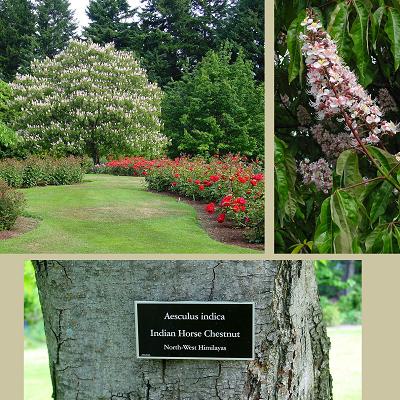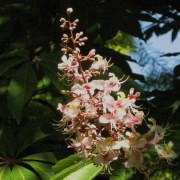Aesculus indica
Contents
Common Names
Indian Horse Chestnut
Family
Description
Glossy dark green leaves changing to orange-yellow in autumn, plentiful white blossoms, fruits are not spiny, suitable for large gardens, used in traditional Indian medicine.
File:138 D.jpg bark |
File:138 E.jpg fruit |
|
| Foliage | deciduous |
| Group | broadleaf |
| Toxic Parts? | no |
| Height | 15 - 20m |
| Crown Diameter | 12m |
| Crown Shape | rounded |
| Shade Tree? | yes |
| Autumn Colour? | yes |
| Age | - years |
| Time to Maturity | 40 - 45 years |
| Flower Colour | white |
| Fruit Colour | |
| Bee Friendly? | yes |
Native Areas
It is common along the Himalayan Lowlands, between Kashmir and Western Nepal at elevations between 900 and 3,000 metres[1]
Preferred growing conditions
| Soil pH Range | 5 - 8.5 (acidic - slightly acidic - neutral - slightly alkaline ) |
| Soil Types | sand, silt, clay, loam, chalk |
| Drainage | well drained |
| Soil Fertility | |
| Sunshine | part sun and full sun |
| Soil Moisture | moist |
| Tolerates Exposure | yes |
| Growth Rate | - medium |
Hardiness
| RHS | USDA | EGF |
| H | 7A | H2 |
How to plant
Water container-grown and rootballed trees well and allow to drain an hour before planting. While it drains dig out an area for the tree that is about 2 to 3 times the diameter of the container or rootball and the same depth as the container or rootball. If the soil is compacted loosen with a fork (this includes the sides of the hole). But beware of having soil that is too loose on the bottom as this will cause the tree to be lower than desired upon watering.
- If container-grown, put the tree on its side and remove the container. Place in the hole and loosen the roots around the edges without breaking up the root ball too much. Check the depth by place a cane or stick across the diameter - only the root collar should be below and not the main stem.
- If planting a balled and burlapped tree, remove ties or nails from the burlap at the top of the ball and using a knife if necessary, pull the top of the burlap back, so it does not stick out of the hole when the soil is replaced. Synthetic burlap should be completely removed as it will not decompose. Note burlap sticking out of the hole can wick water away from the tree.
- For bareroot trees, feel the moisture of the roots by hand - if dry, dunk them in an bucket of water for 10-15 seconds and replace the packaging (if you are not going to plant at that time). Do not plant too deeply - only plant up to the root collar. i.e. the stem should not be covered in soil. Ensure roots are planted firmly and have good contact with the soil.
Fill in the hole with soil and compost, but do not add less than half of the original soil.
Using the soil, create a water ring around the outer edge of the hole. Not only does this conserve water, but it will also direct moisture to the perimeter roots, encouraging outer growth. Once the tree is established, the water ring may be levelled. Studies show that mulched trees grow faster than those unmulched, so add a 3 inch layer of pinestraw, compost, or pulverized bark over backfilled area.
Only prune lower damaged branches if necessary. Water newly planted trees regularly in their first year. Staking is also important in new trees and in exposed areas - a 1 m stake at 45 degrees crossing the stem at a height of 15 cm can provide good support. Be careful of the binding of the stake to ensure the tree is not strangled. Binding should be checked in the second year, as the stem will thicken.
When to plant
Early to mid-Autumn, for cold, wet sites wait until early to mid-Spring. Container-grown trees can generally be planted all year round except when it is very hot and dry or the ground is frozen.
Tree care
| Hedging Potential | no |
| Balcony/Roof Terrace | no |
| Indoors | no |
Potential Pests and Diseases
| Pests | horse chestnut scale, leaf-mining moths, Japanese beetle |
| Diseases | canker, coral spot, leaf spot |
Ecology
History and Human Connection
While common to the Himalayan Lowlands, it was introduced to Britain in 1851 by Colonel Henry Bunbury (a friend of Sir Joseph Hooker, Director of Kew from 1865-1885), who planted seeds in his family’s Suffolk garden. Note all species in the genus Aesculus contain a saponin-class toxin called aesculin. This is poisonous to many animals, including humans, because it destroys red blood cells. In India, the seeds are steeped in water first to remove the toxin and then ground into a flour and roasted [2].
Uses
- The leaves are used as cattle fodder in parts of Northern India. Its seeds are dried and ground into a bitter flour, called tattawakher [1].
- The flour is often mixed with wheat flour to make chapatis and also to make a halwa (Indian sweetmeat) and sometimes is served as a dalia, (a type of porridge or gruel) during fasting periods[1].
- It is used in traditional Indian medicine, for the treatment of some skin diseases, rheumatism, as an astringent, acrid and narcotic, and in the relief of headaches[1].
- It can be cultivated as a bonsai
- The wood is close-grained and easily worked
- As an ornamental tree in temperate regions
References




